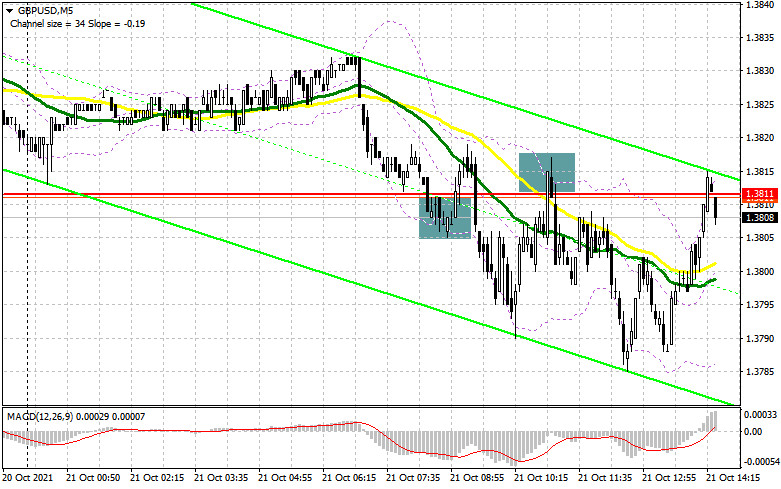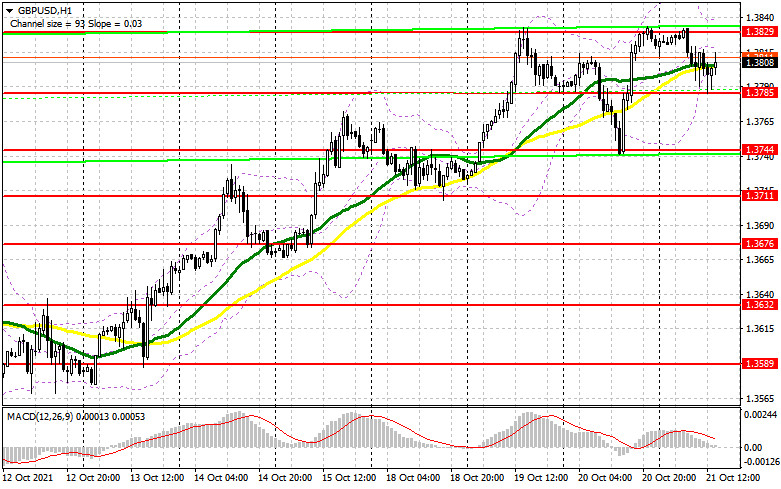To open long positions on GBP/USD, you need:
In the first half of the day, several signals were formed to sell and buy the pound. Let's look at the 5-minute chart and analyze the entry points into the market. I paid attention to 1.3811 and advised buying the pound there when forming a false breakdown. Everything happened according to the scenario: we saw a decline below 1.3811 and then a return to it, which led to a signal to open long positions further along with the trend. But, unfortunately, there was no major upward movement, and after a while, the pound again failed 1.3811, which led to the fixing of losses. Already closer to the middle of the day, it was possible to observe the test from the bottom up of this level, which gave an excellent entry point into short positions. The pair went down by 25 points, and then the sellers' initiative dried up. From a technical point of view, the picture has completely changed.
Trading is more like a side channel with the prospect of accumulating new long positions each time when approaching large support levels. To maintain the bull market, buyers of the pound need to think about how to take control of the weekly high at around 1.3829. Only weak fundamental data on the US labor market, or other statistics concerning the dollar, will help in this. In the afternoon, it is also necessary to follow the speeches of the Federal Reserve System representatives, which yesterday put pressure on the dollar. Only a breakthrough and consolidation above 1.3829 with a reverse test from top to bottom will return the bulls' hope for further growth of the pair within the day and form a new entry point into long positions, opening up the opportunity to update such levels as 1.3877 and 1.3910. A more distant target will be the 1.3955 area. In the case of a decline in the pound, the optimal scenario would be to protect the morning support of 1.3785. The formation of a false breakout forms an excellent entry point into the continuation of the bullish trend. In the absence of active actions on the bulls in the area of 1.3785, the optimal scenario for the long run will be a test of the next support of 1.3744, which is also the lower boundary of the side channel formed by the results of yesterday. I advise you to look at long positions of GBP/USD immediately for a rebound only from the minimum of 1.3711, or even lower - from 1.3676, based on an upward correction of 25-30 points within a day.

To open short positions on GBP/USD, you need:
Sellers are slowly but surely pushing the British pound, but the bulls use this every time to accumulate positions. Most likely, today, the entire focus in the afternoon will be more on the protection of 1.3829 and on the statements of American politicians on the possibility of curtailing measures to support the economy by the Federal Reserve System. Only an unsuccessful attempt to consolidate above 1.3829 and the formation of a false breakdown there form a signal to open short positions against the trend, counting on a fall to today's minimum of 1.3785. An equally important task for sellers will be to take control of this level. The reverse test from the bottom up will form a sell signal with a target of 1.3744, and then to update the minimum of 1.3711, where I recommend fixing the profits. If the pound recovers and there is no willingness to sell at 1.3829, only the formation of a false breakdown near a new high of 1.3877 will signal the opening of short positions in GBP/USD. I advise selling the pound immediately for a rebound from a larger resistance at the base of the 39th figure of 1.3910, and even then, counting on the pair's rebound down by 20-25 points inside the day.

The COT reports (Commitment of Traders) for October 12 recorded a reduction in short and long positions. However, the former turned out to be more, which led to a slight recovery of the negative net position. Despite the bears' relatively active attempts at the beginning of that week to resist the bullish trend, buyers turned out to be stronger, which led to a further increase in the pound against the US dollar. The reduction of several problems with disruptions in supply chains, which shook the pound earlier this month, is now gradually returning to the market players betting on further strengthening of risky assets. Constant speeches and statements by the Bank of England representatives that it is necessary to take inflationary pressure more seriously also add confidence to buyers of the pound. The central bank's meeting minutes last week confirmed the regulator's intentions to take seriously the option of raising interest rates already during the November meeting – a bullish signal for GBP/USD. Therefore, the only problem that stands in the way of buyers of the pound is the US Federal Reserve System. Although they will not raise interest rates, they are also heading for a tightening of monetary policy. However, the British pound looks preferable in these conditions. The COT report indicates that long non-commercial positions decreased from the level of 48,137 to the level of 46,794.
In contrast, short non-commercial positions dropped from the level of 68,155 to the level of 58,773, which led to a partial reduction in the advantage of sellers over buyers. As a result, the non-commercial net position was - 11,979 against -20,018. The closing price of GBP/USD remained almost unchanged at the end of the week: 1.3591 against 1.3606.
Signals of indicators:
Moving averages
Trading is conducted around 30 and 50 daily moving averages, indicating an active market control confrontation.
Note: The author considers the period and prices of moving averages on the hourly chart H1 and differ from the general definition of the classic daily moving averages on the daily chart D1.
Bollinger Bands
A break of the lower limit of the indicator in the area of 1.3785 will lead to a major drop in the pair. A break of the upper limit in the area of 1.3829 will lead to a new wave of growth.
Description of indicators
- Moving average (moving average determines the current trend by smoothing out volatility and noise). Period 50. The graph is marked in yellow.
- Moving average (moving average determines the current trend by smoothing out volatility and noise). Period 30. The graph is marked in green.
- MACD indicator (Moving Average Convergence / Divergence - moving average convergence/divergence) Fast EMA period 12. Slow EMA period 26. SMA period 9
- Bollinger Bands (Bollinger Bands). Period 20
- Non-profit speculative traders, such as individual traders, hedge funds, and large institutions that use the futures market for speculative purposes and meet specific requirements.
- Long non-commercial positions represent the total long open position of non-commercial traders.
- Short non-commercial positions represent the total short open position of non-commercial traders.
- Total non-commercial net position is the difference between the short and long positions of non-commercial traders.











